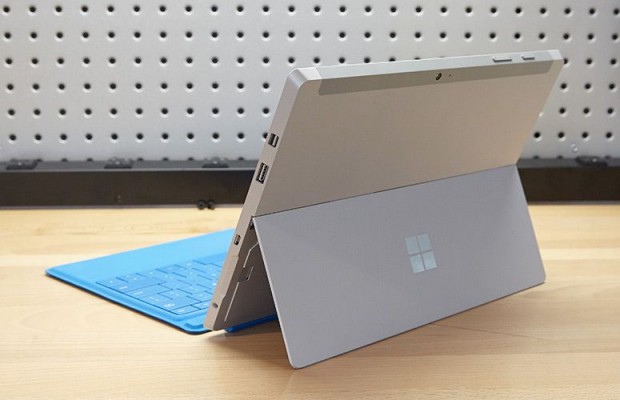A Month with the Surface 3: The Best Tablet Around
The tablet market is declining, and for good reason. These secondary devices just don't do enough to justify their cost. But from their demise emerges a new kind of 2-in-1 that blurs the line between laptop and tablet, headlined by Microsoft's Surface 3 ($499 to start, $629 with keyboard).
To cut through the promise and experience the reality, I swapped out my 13-inch Dell Inspiron at work, and my Samsung Galaxy Tab and desktop rig at home for the Surface 3 for a month. Here's what I learned.
Just the Right Size
I would have killed for one of these in college. The three laptops that I owned during my time at Northeastern University weighed 8.8, 8.1 and 6.4 pounds. With the Surface 3, I have a system that weighs less than 2 pounds (with the Type Cover attached) and is ridiculously easy to carry around. I can even take handwritten notes with the optional $50 Surface Pen.
Granted, my college laptops had much larger screens, but with the ease of connecting the Surface 3 to a TV or external monitor, there would have been no need to strain my shoulder while lugging an oversize system across campus.
No loop? No problem. Even without the pen holder seen on the Surface Pro 3's keyboard, there's still a simple way to stash the Surface Pen when you're not using it.
Smooth Performance, But Windows 10 Will Be Better
Sign up to receive The Snapshot, a free special dispatch from Laptop Mag, in your inbox.
In the office, when I had to flip among Photoshop, multiple spreadsheets and several half-written articles, the Surface 3 had no trouble keeping up. I could even render videos, as long as I didn't need them right away.
The biggest problem I had was with Windows 8.1, which continues to be a hassle for a traditional mouse-and-keyboard setup. But all that will be gone come late July, with the arrival of Windows 10, which features universal apps that break down the barrier between desktop and tablets. There's also a redesigned interface that can sense which mode you're in (tablet or laptop), Microsoft's Cortana digital assistant and the touch-friendly Edge Web browser.
Instant (Media) Gratification
Before heading home, all I had to do was casually toss the Surface 3 into my bag; there's no need to even shut it down first. During my commute, I barely even noticed how heavy it was, and because it was still on, I could pull it out and watch an episode of Silicon Valley, seated or standing, in just a couple of seconds. That is the kind of flexibility I've always dreamed of but never had.
MORE: Best 2-in-1s (Laptop/Tablet Hybrids)
Home Companion
At home, things got even better. While the Surface 3 couldn’t replace my desktop for playing AAA titles like The Witcher 3, for everything else, it's perfect. I used it to view a recipe for sausage and arugula orecchiette pasta from my boy Chef John while simultaneously watching a video detailing its preparation. That's the kind of multitasking iPad users won't be able to do until the fall, when iOS 9 comes out.
When it came to helping me unwind, I wasn’t stuck with the lightweight apps that plague Apple’s and Google's app stores. In the case of my current free-time obsession — space exploration sim Out There — the Surface 3 gave me access to the Omega version on PC, which features bonus endings and voice-acted dialogue instead of the more basic version I play on my phone.
Even the much-maligned keyboard, which is admittedly sometimes a pain when used on your lap, has grown on me. After a single day of using the keyboard, I was back up to my typical typing average of 75 to 80 words per minute, and used it to write this entire piece without a single complaint.
The new micro-USB port makes it a breeze to find a spare cord to juice up the Surface 3, but I felt like it took significantly longer to recharge the tablet than the Surface Pro 3 with its proprietary power connector. Thankfully, the $199 dock kept the Surface 3 charged up, so even over the weekends, when I was away from the office, I never ran out of power.
Bottom Line
Sometimes us tech reviewers get a little too obsessed with clock speeds and transfer tests, because for most people, the Surface 3 is more than fast enough. My biggest problem is that the keyboard, which is really an essential feature, costs an extra $130. This adds a hidden fee to a system that is advertised as starting at $499 — and Microsoft knows it, as evidenced by the asterisk that taunts you in its Web store.
But when it comes to all other sub-$800 systems, the only other machine I'd consider is Asus' UX305. Compared to the Asus, my Surface 3 of choice (the $729 model with 4GB of RAM, a 128GB SSD and Type Cover) has an hour and a half less battery life, but it more than makes up for it with unmatched flexibility.
I think Microsoft got it wrong: The Surface 3 isn't a "laptop replacement"; it's the Kal-El of tablets. It's time to say goodbye to the meager legion of media consumption devices that came before and hello to super tablets capable of a whole lot more.
Sam Rutherford is a writer at Laptop Mag, focusing on laptop reviews and all the gadgets that make using a notebook just that much easier (or more fun). Over the years, he reviewed some iconic laptops, including gaming beasts from Alienware, Asus, Acer, Gigabyte, and HP. Outside of gaming laptops, Sam has also reviewed notebooks oriented around productivity, such as the Lenovo IdeaPad or the Dell XPS.







